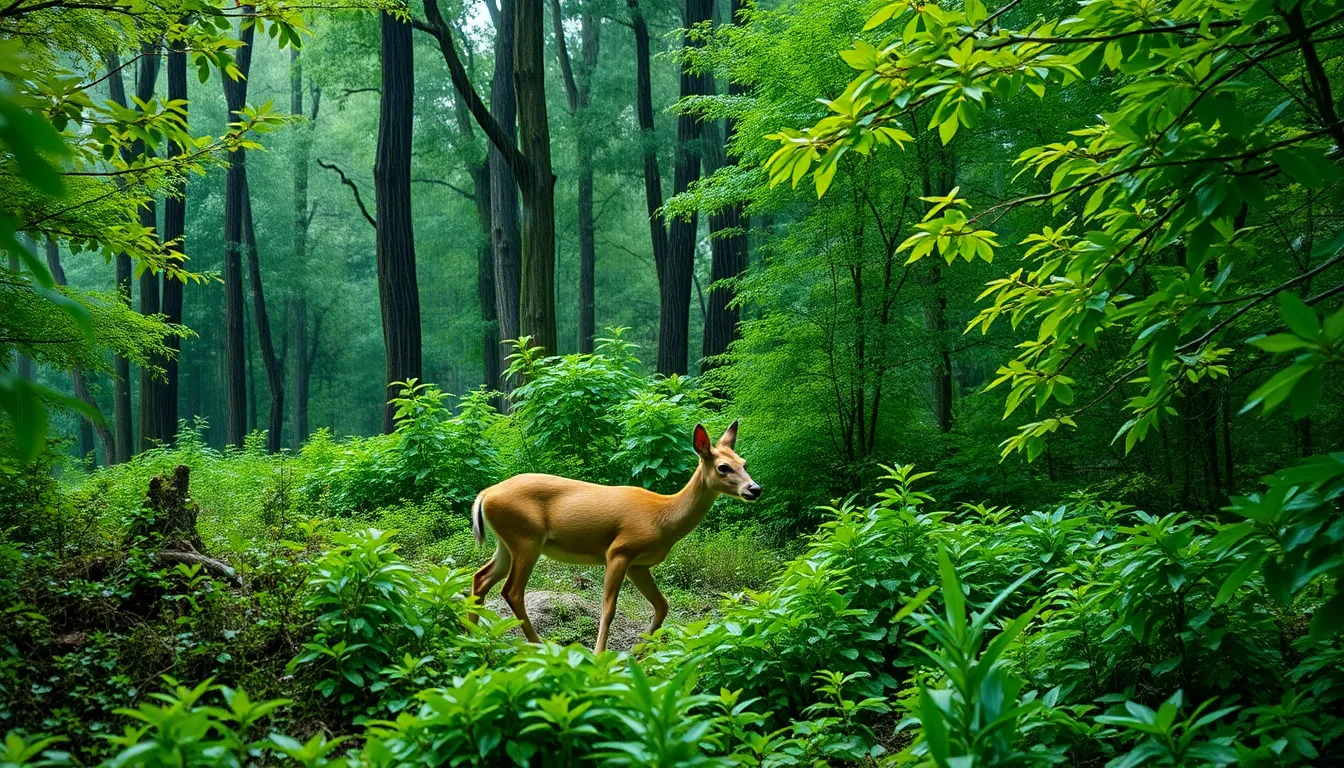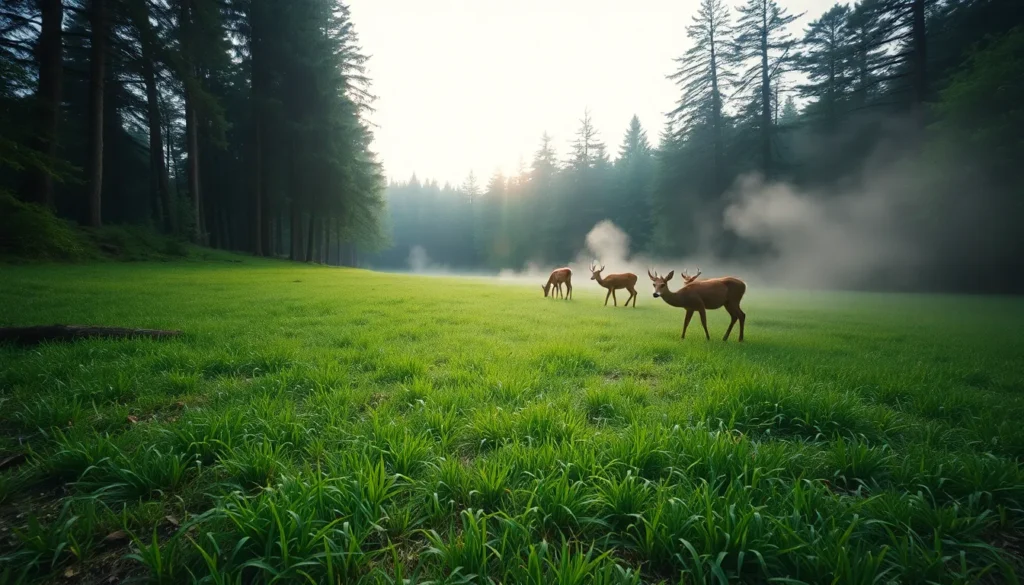When the skies open up and the rain starts pouring, most folks hunker down with a hot drink and a good book. But what about the deer? Do they grab their tiny umbrellas and dance in the puddles, or do they prefer to stay cozy under the trees? Understanding deer behavior in wet weather is crucial for hunters and wildlife enthusiasts alike.
Rain can change the game, and knowing how it affects deer movement could mean the difference between a successful outing and a soggy disappointment. So, let’s dive into the world of our four-legged friends and uncover whether they embrace the rain or retreat into the shadows. With a little humor and a lot of insight, this exploration will leave you wondering if you should pack your raincoat or just stay indoors.
Table of Contents
ToggleUnderstanding Deer Behavior
Deer exhibit unique patterns in response to weather conditions, including rain. When it rains, they often become more active during specific times. Increased humidity may enhance their foraging behavior, drawing them out in search of food.
Movement patterns change as well; deer frequently browse in areas where they can find fresh growth. Wet conditions can create favorable foraging spots, making those locations popular among deer. Consequently, hunters may find that deer are more visible in open fields or meadows shortly after a rain shower.
Shelter-seeking behavior is another aspect of deer activity during rain. Heavy downpours might drive them into thick cover, seeking protection from the elements. In contrast, light rain or mist might not deter them as much.
Environmental factors also influence their movement. Soil moisture encourages the growth of desired vegetation, attracting deer to those regions. Observing changes in terrain can enhance understanding of where deer might be found post-rain.
To sum up, knowing that deer adapt their behavior based on rain can aid hunters and wildlife observers. Adjustments in movement and foraging habits occur with the weather, making it crucial to observe these patterns closely. With the right knowledge, individuals can better anticipate deer activity, maximizing their chances of success.
Factors Affecting Deer Movement


Deer movement patterns in the rain depend on several factors, including weather conditions and time of day. Understanding these variables enhances the ability to anticipate deer behavior.
Weather Conditions
Rain intensity impacts deer activity significantly. Light rain often encourages deer to move, as they feel secure, which increases their foraging opportunities. Heavy downpours, on the other hand, typically push deer into heavy cover, where they seek shelter. Humidity and soil moisture play crucial roles as well. These conditions promote plant growth, drawing deer to freshly sprouted vegetation. Moreover, the presence of wind can alter deer movements, as they may feel more exposed during strong gusts.
Time of Day
Time of day influences deer activity significantly. Early mornings and late evenings remain the most active periods, especially after rain. During these times, they become more likely to forage in open areas. Midday activity tends to decrease, causing deer to rest. Twilight provides a balance between safety from predators and access to abundant food. Recognizing these patterns enhances the chances of spotting deer during and after rainfall.
Do Deer Move in the Rain?
Deer exhibit unique behavior patterns during rainy conditions. Activity levels often increase, especially during light rain, as they take advantage of fresh growth.
Impact of Rain on Deer Activity
Rain significantly influences deer movement. Light rain often encourages increased foraging. Deers seek areas with new vegetation, such as open fields or meadows, right after a shower. Heavy downpours, on the other hand, drive them into thick brush for shelter. Shelter-seeking behavior helps maintain their comfort during intense weather. The immediate aftermath of light rain can see deer venturing out more than usual, while persistent heavy rain dampens their activity levels. Recognizing these patterns can help hunters plan their outings effectively.
Research Findings on Deer Behavior in Rain
Various studies reveal how deer adapt to rain. Research shows that humidity and soil moisture can stimulate plant growth, attracting deer towards fresh forage. A study conducted in the Midwest found that deer frequently increased activity during light rain but stayed sheltered during heavy downpours. Early morning and late evening remain optimal times for spotting deer, particularly after rain. The correlation between weather conditions and deer behavior emphasizes the importance of understanding these interactions. Observing these patterns can enhance both hunting and wildlife observation experiences significantly.
Tips for Hunting Deer in Rainy Conditions
Understanding deer behavior in the rain can enhance hunting effectiveness. Prioritize morning and evening hunts, as these times see increased deer activity. Dress appropriately with waterproof gear to stay comfortable and maintain focus.
Scout locations ahead of time. Identify areas with fresh growth, as deer frequent meadows and clearings after rainfall. Using scent control products helps minimize human scent, crucial during rainy conditions since wet surfaces can intensify odors.
Consider utilizing calls or attractants. Calls are effective, especially during light rain, as sounds carry differently in moisture. When employing attractants, choose natural scents that can mask human odors, drawing deer to the area.
Observe wind direction carefully. Rain tends to shift winds, affecting scent dispersion. Keeping awareness of wind patterns can lead to better positioning during a hunt.
Adapt tracking techniques. Following deer tracks can be easier in wet conditions, as prints remain visible in mud or puddles. Utilize binoculars or a spotting scope to survey distant areas, minimizing movement and noise.
Patience remains essential during inclement weather. Remaining still enhances chances of spotting deer seeking shelter or foraging. Use natural cover to blend in seamlessly with the environment.
Lastly, remain flexible with hunting plans. Weather conditions change rapidly, so adjust to shifting rain intensities. Embrace opportunities as they arise, which can lead to successful hunts even in less-than-ideal conditions.
Understanding deer movement in the rain is essential for anyone interested in wildlife observation or hunting. The varying responses to light and heavy rain can guide strategies for successful outings. Deer often take advantage of the fresh vegetation that appears after rainfall while seeking shelter during heavy downpours.
By recognizing these patterns and adapting to changing conditions hunters can increase their chances of encountering deer. Whether it’s planning hunts during peak activity times or scouting for fresh growth areas patience and flexibility remain key. Embracing the nuances of deer behavior in rainy weather can transform a typical outing into a fruitful experience.



